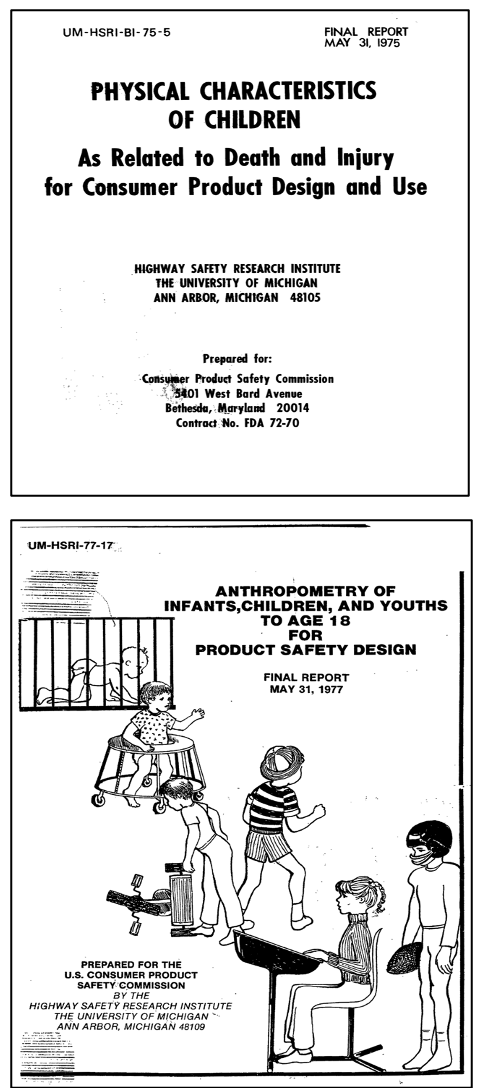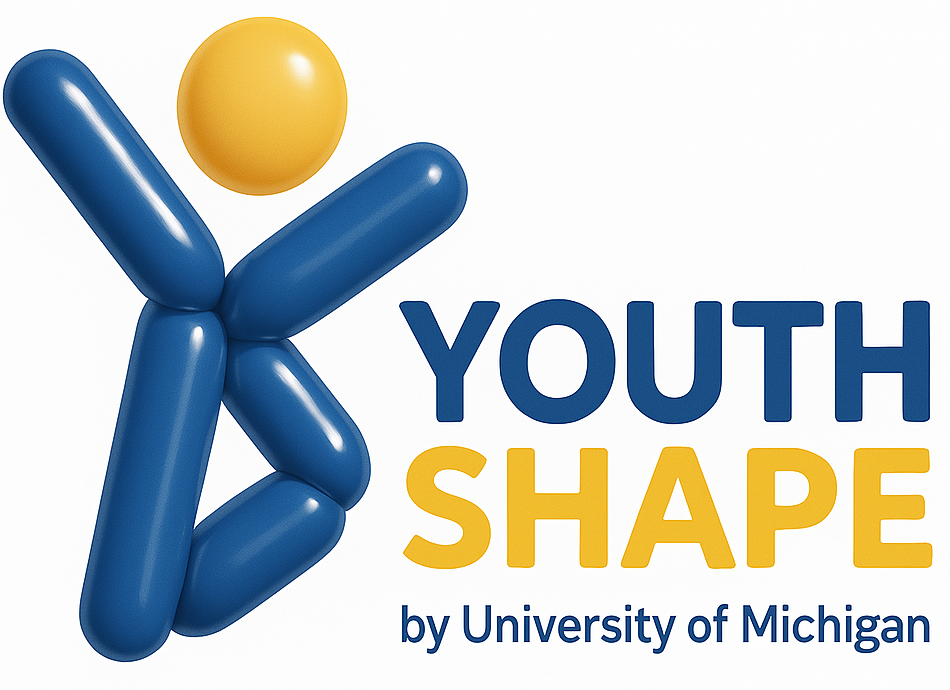Study Background
Information on human body size and shape is critical for the design of products and systems to ensure safe and effective use. Engineering anthropometry has been widely used since the 1950s to design nearly every product that people interact with physically, including clothing, vehicles, and protective equipment. Unfortunately, most collection and use of anthropometric data has changed little since that time. Standard anthropometric dimensions are obtained using manual instruments to measure lengths, breadths, and circumferences at various locations on the body. These values are tabulated and reported, typically as a mean and a few percentiles of each measure. This approach greatly limits the use of the data in design. Among the common problems are that the correlations among the variables are not retained and information on three-dimensional (3D) shape is not available.

State of Child Anthropometry
The availability of useful data for children is even more limited than for adults. The last large-scale survey of U.S. children for which data are publicly available was conducted by our organization (then the Highway Safety Research Institute) in the 1970s. Snyder et al. (1977) gathered manually measured dimensions from 4127 children ages one month to eighteen years. These data are publicly available and widely used, but the population is out of date. Pagano et al. (2015) showed that trends toward higher body weight have changed many important dimensions. Moreover, the 1970s sample is not as diverse as the current population of children and does not include 3D data.
Over the past two decades, technological advances have enabled revolutionary changes in anthropometry. High-resolution surface scanners have provided the means to capture 3D body shape, and associated data processing and analysis methods have enabled more-complex analyses. Although these methods have been applied in several large-scale studies of U.S. civilian and military populations (e.g., CAESAR, ANSUR II), only a few 3D studies of children have been reported.

Objectives
The objective of the YouthShape.US study is to dramatically improve the availability of valid, representative, and comprehensive anthropometric data for U.S. children. Our goals with the survey include:
- Use rigorous manual methods to obtain data that can be compared with prior studies
- Apply state-of-the-art 3D methods to measure and model child surface shape across postures, with a focus on head, hands, and feet as well as whole-body
- Ensure broad representativeness by oversampling previously underrepresented demographic groups, enabling meaningful statistical estimates for subpopulations
- Develop powerful, flexible online apps that enable designers, engineers, regulators, and others to access the information they need without having to learn arcane anthropometric terms and without being limited to the measurements we took directly
Not Just Data: Models and Tools for Practitioners
Although having high quality data is essential, too often prior anthropometry studies have wound up as a few tables of numbers in the back of a publication. That may have been acceptable when ink on paper was the only way to distribute information, but modern online tools open up a vastly larger range of possibilities. Our approach is based on several critical steps:
Data Standardization, Template Fitting, and Avatar Generation
Using methods we have developed over the past 25 years, we carefully process the 3D scan data, removing props and spurious points to ensure clean data for analysis. In many cases, we manually digitize landmarks on the scans to mark important body structures. Then we fit the 3D scans with a high-resolution template. Representing the data on a homologous surface mesh enables statistical analysis. For the hand, foot, and whole-body, we use UMTRI's BioHuman avatar so that the model can be articulated to a wide range of functional poses.
Statistical Shape Models
The data standardization and template fitting allow the creation of statistical shape models. These models encode the variability in the dataset and enable a wide range of applications. A common need is to generate the mean expected body shape as a function of overall descriptors. For this, we generate regression models predicting shape from overall characteristics such as sex, age, stature, or body weight. A typical application for these regression is the development of a human surrogate such as a crash test dummy or helmet test headform.
But shape models are much more flexible. Because they encode the entirety of the variability in the dataset in a compact form, they provide much better ways to sample the size and shape space than picking individuals from the dataset. In the past, 3D databases were often used as sample pools. Analysts interested in a particular application would conduct statistical analyses on one-dimensional measures to identify criteria, then choose the individual in the sample pool who was most similar. This approach has many problems, but one of the most important is that the analysis to choose the individual is not based on 3D information.
In contrast, shape modeling allows an infinite number of body shapes to be generated that lie within the space defined by the data set. This enables surrogates such as design manikins to be accurate constructed as mean representations given the input parameters, avoiding the idiosyncrasies of individuals in the dataset. But many other processes are enabled as well.
Synthesis for De-Identification
Participant privacy is a core value for the YouthShape study. No identifiable information will ever be shared outside of the project team. In the past, privacy considerations have greatly restricted the availability of 3D scan data that include the face. However, statistical shape modeling solves this problem by enabling population synthesis. We are able to de-identify the participant population by sampling from the shape space while scrambling the fine details of the face that would make a participant identifiable. We de-identify the detailed head scan and then merge the result with the whole-body data.
Synthesis for Weighting
No anthropometric sample is ever perfectly representative of the population from which it is drawn. The YouthShape study is a purposive sample based on a stratified approach. We are carefully oversampling Black and Asian children and youth, relative to their representation in the population, so that we can make improved estimates for these groups. We also have found from experience that higher-BMI participants are less likely to volunteer for anthropometry studies, and hence any analysis of anthropometric data from volunteers must include consideration of reweighting for BMI. Our population-level weighting for sex age, race/ethnicity, and BMI is based on a novel analysis of data from the U.S. National Health and Nutrition Examination Survey. In brief, we synthesize an unweighted sample representative of the U.S. and then generate body shapes and dimensions for each individual in the synthetic sample. We are able to demonstrate the accuracy and efficacy of this approach using withheld data.
Online Tools
Our ultimate goal is to improve products and environments used by children. To accomplish this, we must facilitate the use of the data by designers, engineers, regulators, and others who are in a position to use anthropometric data. From decades of experience, we have found a large gap between what designers need and what anthropometry studies provide. Tabular data and static summary statistics are rarely sufficient, and barely scratch the surface of what is possible with 3D data. Even large libraries of 3D scans are limited in their utility without the right tools to analyze and manipulate the data. Our newly developed HumanShape.app platform provides online tools that enable users to directly work with 3D statistical models. No anthropometric knowledge is needed. Users define reference points and dimensions relevant to their design problem that are immediately computed across the entire population. New regression models and boundary cases can be quickly defined for specific applications. And multivariate accommodation calculations can be as simple as specifying the range of the design variables. HumanShape.app is currently in a beta preview stage. If you would like to learn more, please contact us.
Collaboration
This study is a collaboration among many organizations and builds on decades of related work at the University of Michigan Transportation Research Institute. Partners include Humanetics Digital North America, the U-M School of Kinesiology, and Texas A&M Corpus Christi. The YouthShape.US study is financially supported by Reality Labs Research, a division of Meta. If you would like to get involved in this exciting research, please contact us.